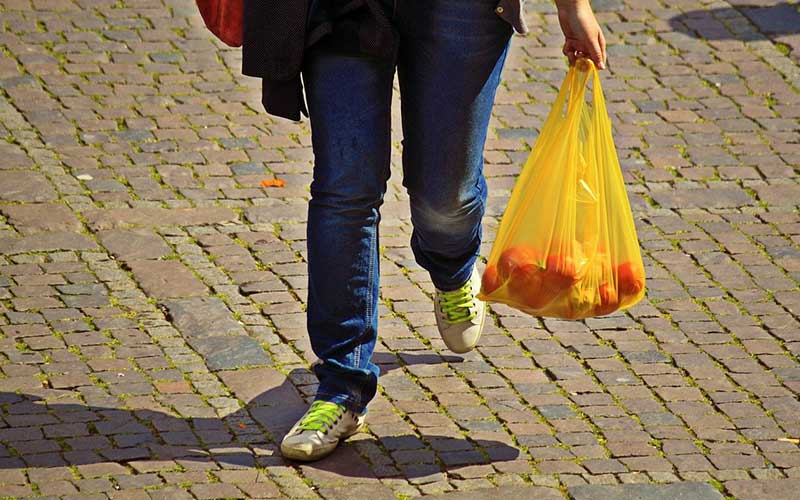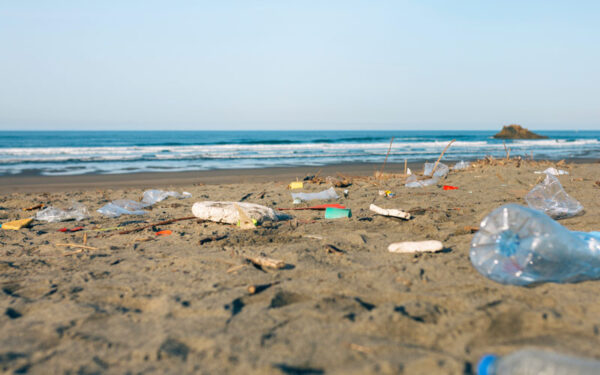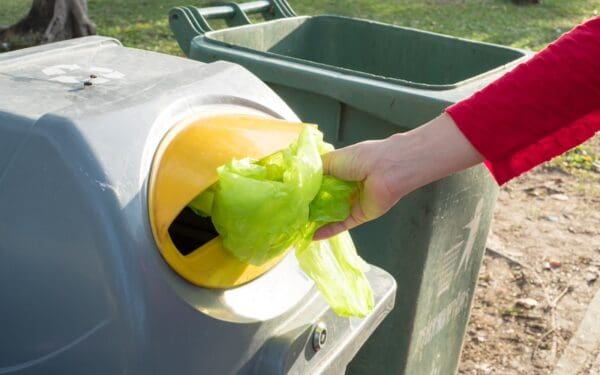
Public health experts have stated that no known cases of COVID-19 have been linked to surface contact, meaning reusable bags and mugs do not increase the risk of infection. Photo: Pixabay
At the outset of the COVID-19 pandemic, the plastic industry claimed that reusable grocery bags could carry and transmit the virus. Though these assertions were false, they worked exactly as the industry wanted them to. Soon, governments and businesses across New England began to temporarily prohibit the use of reusable bags and mugs in favor of plastic ones.
But as more research on COVID-19 and how it spreads has come forth, experts from around the world have stated that no known cases of COVID-19 have been linked to any surface, including reusable bags.
Wanting to set the record straight, we reached out to Dr. Ben Locwin, a healthcare executive and consultant with the FDA and CDC, who is working on the front lines of the national coronavirus pandemic.
The fact is, Dr. Locwin told us, disposables aren’t inherently safer than reusables. Inside a restaurant, for example, you are much more likely to be infected by your fellow diners than from reusable dinnerware. And at the grocery store or coffee shop, regular washing of your bags and mugs with soap or detergent will reduce any theoretical risk of transmission.
Let’s be clear here: Reusable bags, mugs, and utensils do not increase the risk of infection from COVID-19. Moving from reusables to a disposable culture is, as Dr. Locwin notes, “pure scientific nonsense.”
Below is more from our conversation with Dr. Locwin, edited for clarity.
What is your role as a public health expert, and how are you working with COVID-19?
I’ve been working on the front lines with COVID-19 patients since the last week of February – assessing patient cases, mostly in the Northeast region of the United States. I’ve also been taking a look through epidemiological data in the state and also nationwide and worldwide.
I’m on an advisory panel for state governments, as well as some federal panels, for public health outreach and education in order to provide consistent messages to the public in terms of what the best science we have at the moment is saying about COVID-19, how people can protect themselves, and what the future should look like.
Could you briefly explain how COVID-19 spreads?
We’ve known a lot about coronaviruses for over six decades now. And on working from an evidence base of the past, we know how certain coronaviruses go from animals to humans and how these viruses spread through communities.
It is very clear to me that respiratory transmission is the predominant route for this particular situation.
Could you elaborate on that?
Sure, so let’s take the Boston area – some of the first cases that were reported in the news were the three Biogen executives who were at the Boston Marriott Long Wharf hotel. But for the virus to have penetrated so deeply into the population the way it seemed to, and shortly after that conference, means it had likely been transmitting from person to person longer than those initial estimates suggest.
That’s one of the insidious things with this particular coronavirus. Not only is there a 14-day incubation period if you’ve been exposed, but there’s also a high number of asymptomatic carriers who don’t necessarily have classic symptoms, yet they have the potential to transmit it to other people.
So, while these asymptomatic carriers may feel fine, they’re going out in public, they’re talking, coughing, sneezing, and potentially infecting anybody nearby.
One of the concerns now – as we’re within the first few phases of reopening our states – is that people are becoming less cautious. People are gathering at parks and beaches, and they’re not wearing masks. And in so doing, the likelihood of continued transmission is very high.
There are no known cases of contact transmission of COVID-19 and even the CDC has said that touching surfaces or objects is not thought to be the main way the virus spreads. Is there a scenario in which someone could get COVID-19 from touching a surface?
There’s always a theoretical risk of surface contact transmission occurring. But you’re right, we’ve not confirmed any cases of contact transmission of COVID-19. You are overwhelmingly more likely to be infected by other people through breathing in these incredibly small respiration particles.
Surface transmission could occur if somebody who has a positive confirmed case of COVID-19 transmits infected saliva and mucous droplets from their hands onto an item they touch, like at the grocery store. You would need to come by shortly after and touch the exact spot where those viral particles were deposited, potentially contaminating your own hand. But it’s not going to be a risk for you by virtue of viral particles being on your fingertips. You would have to bring that contact surface transmission into your own mucous membranes for infection to occur.
The likelihood of that occurring is low compared to situations where you’ve got 10, 20, 50 people who are talking, eating, walking around, and breathing the same air.
If you’ve got good awareness, good vigilance with your own behavior – you’re not touching your eyes, nose, and mouth when you get home from being out in public, you wash your hands thoroughly as has been described by the CDC, and you’re using hand sanitizer – you can dramatically limit the risk.
One of the lightning rod concerns in New England is reusables, and, in particular, reusable bags. Does limiting reusable bags in grocery stores actually protect customers and staff?
As far as reusable bags are concerned, the likelihood that bacteria or viral particles on your bag – if they exist – are going to transfer from your bag to your hand, to an object that you touch in the store, and infect someone else who touches that same object, is extraordinarily low.
While there haven’t been many studies as far as reusable bags’ ability to transmit infection, there was some research done about 10 years ago by Gerba and colleagues from the University of Arizona, which looked at the washability of reusable bags that had been inoculated with certain bacteria.
Generally speaking, there are a lot of bacteria that are much more resilient to cleaning than viruses (such as SARS-CoV-2). The coronavirus is very susceptible to soaps and detergents, which is one of the reasons hand-washing is so effective.
What the Gerba study found was that biological contaminants on reusable shopping bags were reduced by about 99% when exposed to a wash cycle. The bottom line is virtually all contaminants on the bag’s surface are likely to be removed or degraded by simply washing and drying them.
I think the guidance that has been put into place around reusable shopping bags is really designed to try to make the public feel better, because prohibiting the use of reusable bags doesn’t actually reduce the spread, relative to aerosol routes.
How often should we be washing our reusable bags, mugs, and other items?
I’m sure that most people have historically washed their cups and mugs after every single use. So, the same recommendation applies now. If you bring a cup or a mug to a coffee shop, you would get it filled, use it throughout the day, and wash it when you’re done.
The same goes for reusable shopping bags – after every trip or every couple of trips out in public, you should put your bags through a standard washing cycle. Because the coronavirus is particularly susceptible to soap and detergent, washing your reusable bags will do a great job of removing the potential for this particular virus to be transmitted.
People should consider their reusable bags and mugs like they might their face masks or anything else. If they’ve brought it out in public and used it, when it comes home, it can be washed and ready for the next time.
The real risk is people congregating together and breathing in the same air, yet reopening guidelines for restaurants include the use of disposable food-ware as a safety measure. What is the disconnect here?
Humans love their ritualism. So, in creating some of the guidelines and new structures that we’re all being forced to adopt, we’re undertaking endeavors that are sociological in nature, and not really scientific.
The trouble with giving people guidance is as soon as you provide a metric – like six feet – they’ll strive to achieve exactly that and no more. But six feet, in my mind, was never really sufficient in the first place. I have said it should be at least ten feet, and, frankly, that’s not even optimal. So, the idea that there’s an invisible six-foot barrier – on one side you’re guaranteed to be infected and on the other side you’re totally safe from infection – is nonsense.
What restaurant owners are doing now is measuring their tables to be six feet apart. But it doesn’t make logical or scientific sense for people to be in close proximity to one another at a restaurant and point to reusable plates and utensils as the issue. In fact, when tables are set six feet apart, the seating at the extremities (where the end of one table’s seat intersects with a seat at the end of another table) are very much closer together than that – often more like one-and-a-half feet. It’s patently not the utensils that are the risk here.
So, are there actual safety benefits using disposable tableware at a restaurant?
Disposables aren’t inherently safer than standard restaurant tableware. Reusable glasses, plates, and utensils, all go through super-heated cycles of water and very strong detergents as part of the industrial wash cycle – and that’s what’s always happened, it’s not new for COVID-19.
The idea of purely using disposable food-ware avoids having to think about the causality chain of how our glasses, plates, and utensils are actually getting to the table in the first place. Whether disposable or reusable, a server will carry those items to your table. So here, we have everyone worried about contact transmission, yet we haven’t eliminated contact from this whole situation.
To assume that a fragile virus, like coronavirus, requires us to change everything and go to a totally disposable culture is pure scientific nonsense.
We can’t let you go without asking one more question that is on a lot of people’s minds right now. Face masks: Do they or don’t they help slow transmission of COVID-19?
If we assume 100% mask compliance is in place, then ‘yes,’ for the most part, the respiratory droplets everyone is producing are not being cast into the air for others to breathe in. And the argument that the spaces in a mask’s mesh are larger than a viral particle misses the entirety of understanding the point in the first place: Viral particles are being cast out by carrier droplets, and these are very much larger than the viruses themselves, and that’s what the masks are stopping – and doing it very effectively. It’s not a question of ‘do masks work?’ but ‘are masks being put on, removed, and handled properly?’
That’s why this whole idea of serially applying masks in public tends to work very well. What we do know is that countries with widespread mask mandates have seen their curves progress very differently than other countries.
So, in my mind, that’s really the end of the argument. We’ve got empirical data showing that widespread mask use works. And it works for the reason that you’re stopping a lot of potential transmission at the source.




